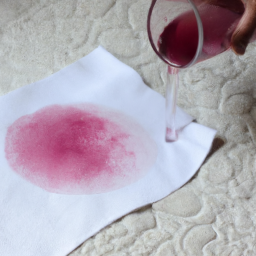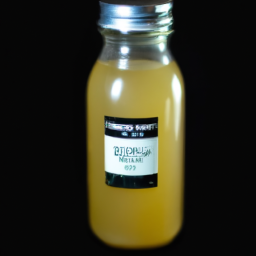As a carpet owner, I know the frustration of dealing with a spilled drink and the dreaded sight of a bright red cranberry juice stain on your carpet. But fear not, I am here to help you learn how to effectively remove this stubborn stain with the right tools and know-how.
First and foremost, time is of the essence when it comes to spills. The longer the juice sits on the carpet, the harder it will be to remove. So, take quick action and follow these steps to get your carpet looking like new again.
With a little bit of effort and the right tools, you can say goodbye to that unsightly cranberry juice stain for good.
Key Takeaways
- Act quickly to address the spill, blotting the stain with a clean cloth or paper towel.
- Test a small spot of the carpet with any cleaning solution before attempting to remove the stain.
- Use a mixture of vinegar and water, or dish soap and water, as an alternative to commercial cleaners.
- Rinse the carpet with clean water and allow it to dry completely before assessing the stain and repeating treatment if necessary.
Act Quickly
Don’t panic, but you gotta act fast if you wanna save your carpet from the wrath of that pesky cranberry juice stain! The longer you wait, the deeper the stain will set into the carpet fibers, making it much harder to remove.
So, the first thing you need to do is grab some paper towels or a clean cloth and start blotting up as much of the juice as possible. Blotting techniques are crucial at this stage because you want to avoid rubbing the stain and spreading it further. Instead, place the paper towel or cloth over the stain and apply gentle pressure to soak up the juice. Repeat this process until you have removed as much of the cranberry juice as possible.
Once you have blotted as much as you can, it’s time to move on to the next step: gathering the right tools.
Gather the Right Tools
Golly, you’ll wanna grab some tools pronto if you’re aiming to erase the evidence of that spilled crimson concoction from your beloved floor coverings. Before you start, make sure you have the necessary tools to clean the carpet properly.
Here are three items you’ll need to gather:
- A clean white cloth or paper towels to blot the stain.
- A spray bottle filled with a mixture of equal parts white vinegar and water.
- A carpet cleaner or stain remover specifically designed for cranberry stains.
Safety precautions are also critical when dealing with cleaning solutions. Make sure to wear gloves and protective eyewear to avoid any potential harm. Keep the area well-ventilated to prevent inhaling fumes from the cleaning solutions.
Once you have all the necessary tools and safety precautions in place, it’s time to move on to the next step: testing a small spot. This will ensure that the cleaning solution you’re using doesn’t damage or discolor your carpet.
Test a Small Spot
Before you start cleaning, it’s important to test a small spot on your carpet to make sure the cleaning solution won’t cause any damage or discoloration. While cranberry juice stains can be difficult to remove, you don’t want to make the situation worse by using a cleaning solution that is not suitable for your carpet.
To test a small spot, first, choose an inconspicuous area of your carpet, such as a corner or under a piece of furniture, and apply a small amount of the cleaning solution. Wait for a few minutes, then blot the area with a clean, white cloth. If there is no color transfer or damage to the carpet fibers, then it’s safe to proceed with the cleaning.
Possible alternatives to using a commercial cleaning solution include using vinegar and water, or a mixture of dish soap and water. However, it’s important to keep in mind that these alternatives may not work as effectively as a commercial cleaner and may also cause discoloration or damage to certain types of carpet.
Additionally, common misconceptions about cleaning cranberry juice stains include using hot water or rubbing the stain vigorously, which can actually set the stain deeper into the carpet fibers.
Now that you have tested a small spot and determined the appropriate cleaning solution, it’s time to begin the treatment.
Begin the Treatment
Now it’s time to dive in and start tackling that stubborn cranberry juice stain on your carpet. First things first, make sure to prevent future carpet stains by blotting up any spills immediately and using carpet protectant spray.
When it comes to DIY cleaning solutions, there are a few different options for removing cranberry juice from carpet. One popular method is to mix equal parts white vinegar and water, then apply the solution to the stained area and blot with a clean cloth. Another option is to create a paste using baking soda and water, apply it to the stain, let it dry, and then vacuum it up. Whichever method you choose, make sure to test it on a small, inconspicuous area of your carpet first to ensure that it won’t cause any discoloration or damage.
Now that you’ve begun treating the stain, it’s time to move onto the next step: rinsing the carpet.
Rinse the Carpet
To rinse your carpet, you’ll need to grab a bucket of clean water and a clean cloth or sponge. Before rinsing, make sure to blot up as much of the cranberry juice stain as possible using the blotting technique. This will help to remove as much of the juice as possible before rinsing.
Once you have blotted the stain, it’s time to rinse the carpet. Here are some steps to follow:
- Dip the cloth or sponge into the bucket of clean water.
- Wring out the excess water from the cloth or sponge.
- Gently blot the affected area with the damp cloth or sponge.
- Continue to rinse and blot the area until all of the cranberry juice has been removed.
- If the stain persists, you can try using a vinegar solution to help break down the stain.
With the cranberry juice stain now rinsed out, it’s time to move onto the next step of the cleaning process: drying the carpet.
Dry the Carpet
Congratulations, you’re almost done! The final step is to let the carpet dry completely before enjoying your clean and fresh space once again.
After rinsing the carpet, use fans to speed up the drying process. Position the fans to blow air directly onto the wet spot, encouraging evaporation. If you don’t have any fans, open windows and doors to promote air circulation throughout the room.
While waiting for the carpet to dry, avoid rubbing or vacuuming the wet area. Doing so can push the stain deeper into the fibers, making it more difficult to remove. Instead, gently blot the spot with a clean, dry towel to absorb as much moisture as possible.
Once the carpet is completely dry, you can assess the stain and repeat treatment if necessary. Transitioning into the subsequent section, remember to be patient and give the carpet enough time to dry completely. This will ensure that the stain is fully removed and that the carpet looks its best.
Repeat Treatment if Necessary
If the stain is still visible after the first treatment, don’t worry, you can repeat the process to ensure complete removal and a fresh-looking carpet. It’s important to note that you should wait for the carpet to dry completely before attempting another treatment. Repeating the process too soon can cause the stain to spread and make the situation worse.
Here are some alternative methods you can try if the first treatment doesn’t work:
- Mix equal parts white vinegar and water and apply to the stain using a clean cloth.
- Use a carpet stain remover specifically designed for cranberry stains.
- Try using a mixture of baking soda and water to create a paste and apply it to the stain. Let it sit for a few hours before vacuuming it up.
It’s important to remember that preventing stains from happening in the first place is the best way to keep your carpet looking fresh and clean. In the next section, we’ll discuss some tips for stain prevention that can help you avoid future incidents.
Prevent Future Stains
One way to keep your carpet looking clean is by taking preventative measures to avoid future stains. Stain prevention is key in maintaining a clean and healthy environment in your home. Regularly cleaning up spills and messes immediately can prevent them from setting in and becoming permanent stains. This can be achieved by using a white cloth or paper towel to blot up the spill, instead of rubbing it in further.
In addition to cleaning techniques, there are also preventative measures that can be taken to avoid future stains. One helpful tip is to remove your shoes before entering your home, especially if you have been walking in wet or dirty areas. Another way to prevent stains is by using carpet protectors, such as mats or trays, under high traffic areas or areas where spills are likely to occur. By taking these preventative measures, you can avoid future stains and keep your carpet looking fresh and clean. As we move forward to regular carpet maintenance, it is important to remember that prevention is key in maintaining a clean and healthy environment in your home.
Regular Carpet Maintenance
To maintain a healthy and clean environment in your home, it’s important to regularly maintain your carpet. This not only helps to prolong the life of your carpet, but it also prevents the buildup of dirt, dust, and other allergens that can negatively impact your health.
One of the most important aspects of regular carpet maintenance is vacuuming frequency. Ideally, you should be vacuuming your carpet at least once a week, if not more often in high-traffic areas.
In addition to regular vacuuming, spot cleaning techniques are also important to keep in mind. Accidents happen, and if you spill something on your carpet, it’s important to act quickly to prevent stains from setting in.
Blot the spill immediately with a clean cloth or paper towel to absorb as much of the liquid as possible. Then, use a carpet cleaner or a solution of water and vinegar to gently clean the affected area. Avoid using harsh chemicals or scrubbing too vigorously, as this can damage the carpet fibers and make the stain worse.
By incorporating these maintenance techniques into your regular cleaning routine, you can keep your carpet looking and smelling fresh for years to come.
Frequently Asked Questions
Can I use any type of cleaner to remove cranberry juice stains from my carpet?
As a knowledgeable individual, I would advise against using any type of cleaner on a cranberry juice stain without first testing it on an inconspicuous area. Alternative solutions may include blotting with a mixture of water and vinegar, or using a commercial carpet cleaner. Prevention tips include immediate blotting and avoiding colored drinks on carpets.
What if the cranberry juice stain has already set in before I noticed it?
When a cranberry juice stain has set in, it can be difficult to remove. Preventative measures are key, but effective tools and techniques can still help. I know from experience that quick action is crucial.
Will using too much water to rinse the carpet cause damage or shrinkage?
Preventing shrinkage and damage to carpets when rinsing with water is important. Using too much water can cause the carpet to become oversaturated, which may lead to shrinking and warping. Proper drying methods can help prevent these issues.
Is it safe to use bleach or other harsh chemicals to remove cranberry juice stains from my carpet?
Bleach and harsh chemicals are not recommended for removing carpet stains as they can damage carpet fibers and discolor the area. Alternative methods and natural solutions, as well as preventative measures like spill proofing, are safer options.
How long should I wait before allowing anyone to walk on the carpet after treating a cranberry juice stain?
To prevent further damage to the carpet, it’s important to wait at least 24 hours before allowing anyone to walk on it after treating a stain. Taking preventative measures, such as using a stain-resistant carpet or placing protective mats, can also help.
Conclusion
So there you have it, a step-by-step guide on how to get cranberry juice out of your carpet. The key is to act quickly and gather the right tools before beginning the treatment. Don’t forget to always test a small spot first to ensure the treatment won’t damage your carpet.
But did you know that, according to a recent survey, cranberry juice is one of the top 5 most common stains on carpets? This just goes to show that accidents happen, and it’s important to be prepared to handle them properly.
By following the steps outlined in this article, you’ll be able to effectively remove cranberry juice and other common stains from your carpet, keeping it looking fresh and clean for years to come. And don’t forget to regularly maintain your carpet to prevent future stains!
Ilana has been a vegan for over 10 years. She originally made the switch for health reasons, but soon found herself becoming more and more passionate about the ethical and environmental implications of a vegan lifestyle. Ilana is the author of The Graceful Kitchen, a blog all about veganism. She loves to cook up delicious and nutritious vegan meals, and share her recipes with others who are interested in leading a cruelty-free life. Ilana is also a strong advocate for using whole foods as the foundation of a healthy diet, and believes that going vegan is one of the best ways to achieve this.










